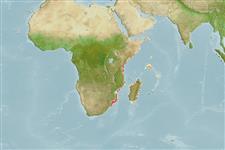Elasmobranchii (sharks and rays) >
Carcharhiniformes (Ground sharks) >
Pentanchidae (Deepwater catsharks)
Etymology: Bythaelurus: bythos (Gr.), depths of the sea, referring to its deepwater habitat; ailouros (Gr.), cat, probably an allusion to the vernacular “catshark,” so named for its cat-like eyes (See ETYFish); lutarius: Latin for “of the mud,” referring to its habitat on or just above muddy bottoms at 338-766 m (See ETYFish).
Environment: milieu / climate zone / depth range / distribution range
Ecology
Marine; bathydemersal; depth range 338 - 766 m (Ref. 5510). Deep-water; 13°N - 29°S
Western Indian Ocean: off Mozambique (Ref. 5578) and Somalia.
Length at first maturity / Size / Weight / Age
Maturity: Lm ?, range 30 - ? cm
Max length : 34.0 cm TL male/unsexed; (Ref. 244); 39.0 cm TL (female)
Short description
Identification keys | Morphology | Morphometrics
Dorsal spines (total): 0; Anal spines: 0. A slender, dwarf catshark with a moderately long snout and short labial furrows; caudal fin without crest of enlarged denticles (Ref. 5578). Dull grey-brown, paler ventrally, with few poorly defined dorsal saddles that may be visible (Ref. 5510).
Found on the continental slope on or just above muddy substrates (Ref. 5578). Feeds on cephalopods, small bony fishes, and crustaceans (Ref. 5578). Probably caught with bottom trawls (Ref. 30573).
Ovoviviparous, with 2 pups per litter (Ref. 5510).
Compagno, L.J.V., 1984. FAO Species Catalogue. Vol. 4. Sharks of the world. An annotated and illustrated catalogue of shark species known to date. Part 2 - Carcharhiniformes. FAO Fish. Synop. 125(4/2):251-655. Rome: FAO. (Ref. 244)
IUCN Red List Status (Ref. 130435: Version 2024-1)
Threat to humans
Harmless
Human uses
Fisheries: of no interest
Tools
Special reports
Download XML
Internet sources
Estimates based on models
Preferred temperature (Ref.
123201): 9.4 - 12.4, mean 11.4 °C (based on 17 cells).
Phylogenetic diversity index (Ref.
82804): PD
50 = 0.5001 [Uniqueness, from 0.5 = low to 2.0 = high].
Bayesian length-weight: a=0.00355 (0.00175 - 0.00721), b=3.08 (2.90 - 3.26), in cm total length, based on LWR estimates for this (Sub)family-body shape (Ref.
93245).
Trophic level (Ref.
69278): 4.2 ±0.56 se; based on food items.
Resilience (Ref.
120179): Very Low, minimum population doubling time more than 14 years (Fec=2).
Fishing Vulnerability (Ref.
59153): Low to moderate vulnerability (29 of 100).
